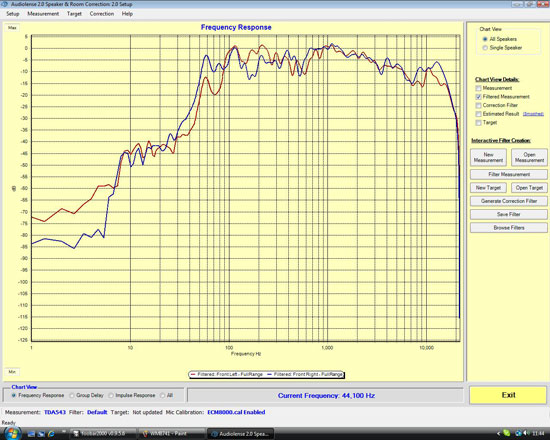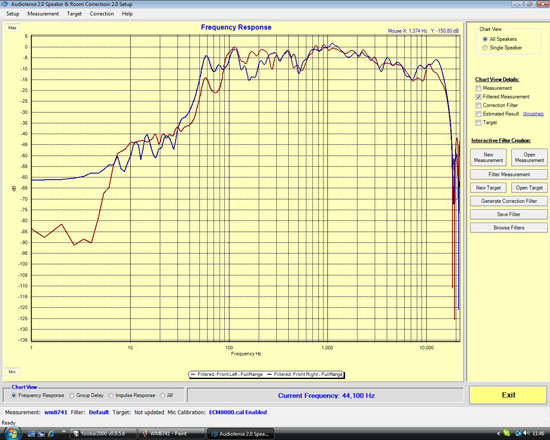Subjective Listening - Arrrgh!
For audio playback, we use Foobar 2000 alongside Windows Media Player. All music is transferred first to the hard drive in WAV format using Exact Audio Copy at a 4x read speed. Before we continue with subjective listening impressions, let's take a look at the measured room response of both DACs and listen to a couple of tracks without any DRC engaged.
The lowish output voltage of the passive I/V configured TDA1543 means we have to attempt to balance volume as best we can with the 2V output of the tube/transformer output of the Opus DAC for comparison purposes. After some adjustment and re-attempted measurements, we get a close enough match to see how the room responds to the Opus. Microphone gain and placement was kept at exactly the same point throughout the course of taking measurements. Each measurement was taken a number of times to see if any drastic changes could be observed.
Doede DAC Red=Left speaker, Blue=Right. Due to furniture placement, there is a 10dB offset between the channels at around 162Hz. |
The response is of the Transparence speakers with the TDA1543 is pretty much as expected, rolling off sharply under 60Hz and over 13.5k.
Opus |
Unsurprisingly, there's little to divide the two room sweep responses. The question is how both DACs sound when compared subjectively, both with and without DRC.
Listening tests are conducted using tracks from Maxwell's Urban Hang Suite and Embrya albums. Both albums feature music containing deep articulate bass lines, with vocals and instruments that should stress every part of the Bicone Signature frequency response.
Firing up "Til The Cops Come Knocking" on the Doede DAC first, the thing that strikes me is its directness. Soundstage height and depth can be best described as compact with a focused central image. This creates the perception of the vocalist sitting a couple of feet in front of the speakers. Instruments also have a "hang in the air" factor, without any real overemphasis on the finer details or decay of sounds. If "in your face" reproduction of micro details is important to you, you'll find you'll have to concentrate on hearing them with this unit in the loop. Everything's there, but you don't get buckets of spatial information that enhances micro-detail presence. Maybe that's the way it's supposed to be?
Rendition of high frequency sounds such as cymbals is on the smooth side compared to what I can recall from the Legato DACs of the Pioneer. I guess this may be a trait of non-oversampling. Overall, I'm quite impressed by the sound, considering the uncomplicated approach of Doede's implementation of the TDA1543. Subjectively, the sound has a very neutral character yet still manages to present itself without a fatiguing nature.
Now it's time to check out how the Opus fares in comparison. Both DACs are connected to the preamp simultaneously so that I can switch over quickly between the two while memory is still fresh. I spin up the same tracks from Maxwell and I'm amazed to find the perceived difference in presentation is far more apparent than I'd expected. The vocal forwardness of the TDA1543 is gone; the same vocal rendition sits further back between the speakers but has gained the impression of extending past the height of the baffles, and background instruments seem to have shifted back by a good few feet. The compact soundstage impression that the TDA1543 gave has been replaced with something far more expansive and spatial and the focus is now on all the elements of the recording. The finer details are readily apparent with the Opus; everything is projected in its own space and draws your attention. Mid-bass does not sound as prominent as it did on the TDA1543, the notes seem to be a little leaner and perhaps more analytical. Vocals and cymbals are especially alluring, something that we can put down to the sonic traits of the 3A5s on the output of the WM8741 DACs. To confirm the perceived differences I keep switching back and forth between the two units, each time amazed that the change is so apparent.










114 Comments
View All Comments
Christobevii3 - Monday, December 1, 2008 - link
What about using a dts/ddl sound card to output to a basic receiver?Rajinder Gill - Monday, December 1, 2008 - link
If going to the nth degree for 2 channel it’s hard to look past USB-I2S in async. For multichannel, a DTS/DDL card is perfectly adequate. Although I’d still use an external solution if I could find one.wolrah - Monday, December 1, 2008 - link
How do you figure I2S is any better than S/PDIF? S/PDIF supports up to 20 bit resolution at either 48 or 44.1 KHz, so it can carry a CD audio stream natively. The bits on the disc are the bits flowing out the optical port on the back of your gear of choice.In theory an I2S signal will be able to take more interference, but when we're talking optical signals in a home environment the kind of interference needed to make a difference would be on the scale that you'd never be able to listen to anything.
Goty - Monday, December 1, 2008 - link
Well that's easy to answer:Nope. I'll stick with my Martin Logans, tyvm.
wolrah - Monday, December 1, 2008 - link
In fact it easily can, because plain and simple reading from the disc itself is error prone. A one time rip to WAV or [lossless format of your choice] using cdparanoia on its insane mode output through a high quality sound card will be the same as or better than any silly 4 digit CD player.Even playing straight off the disc, there's no reason to believe any "audiophile" gear will play a CD any better than any other CD player unless there's a design flaw like a crappy power supply.
On the note of power supply, am I the only one who laughed at the bit about the battery vs. the wall wart? Who wants to bet that he's never double-blind tested that one. That's the wonderful thing with A/V gear snake oil, it's very easy to hear what you want to hear.
mindless1 - Monday, December 1, 2008 - link
I've hand-built amps for years and double-blind tested batteries and wall warts. Yes there is a difference. A good (read: overkill for anyone not into building audiophile equipment) localized power filter stage, if not localized regulation, would ideally negate the difference between the two power sources but that can also unnecessarily increase the build complexity, time, and cost.PS the battery is almost always inferior assuming the wart has proper shielding or is inadequate in capacity, and generally I refer to a wart as only a transformer and rectification stage, not trying to build an entire high precision linear regulation stage inside of it due to limited space and EMI.
Rajinder Gill - Monday, December 1, 2008 - link
Martin Logan makes electrostatic loudspeakers if I recall.I'm not sure where that fits into using a PC as a transport and for DRC. Unless you're refering to the approval of open baffle design loudspeakers using te supravox drivers?plonk420 - Monday, December 1, 2008 - link
this is surreal...my $20 Chaintech AV-710 just died in the last 48 hours. i've been trying to resist the Head-Fi audiophile talk and try to find cooler heads to verify whether or not i should go X-Fi or DAC (something silly looking like the HotAudio HotUSB1 or Silverstone), or try to figure out if i'm experiencing the placebo effect "falling back upon" my ALC883, which i can swear "doesn't sound as good" EVEN THOUGH i'm fully aware of the power of placebo.
i'm not sure i liked the mixed bag of positive and negative reports on (cheap) X-Fi vs Xonar vs X-Fi USB vs some DAC vs E-Mu 0404/0202
mindless1 - Monday, December 1, 2008 - link
Choose a Creative card for gaming sound effects. Choose a DIY DAC for highest audio quality at a reasonable price. Buying some cheap commodity grade DAC is a gamble, I'm not familiar with those two products you mentioned but generally in the consumer segment and price range you end up buying an idea, a type of tech but not excellence in that execution.MOtherboard integrated audio usually doesn't sound as good including one using ALC883, though someone with poor hearing or gear may notice the difference less and less depending on where the weakest link in the chain is and how bad it is.
Gannon - Monday, December 1, 2008 - link
I have an X-Fi and it's better then my audigy, mind you I got the more expensive version with front panel and the remote. I use it for everything and have never had a problem, though I don't use vista at all just XP.